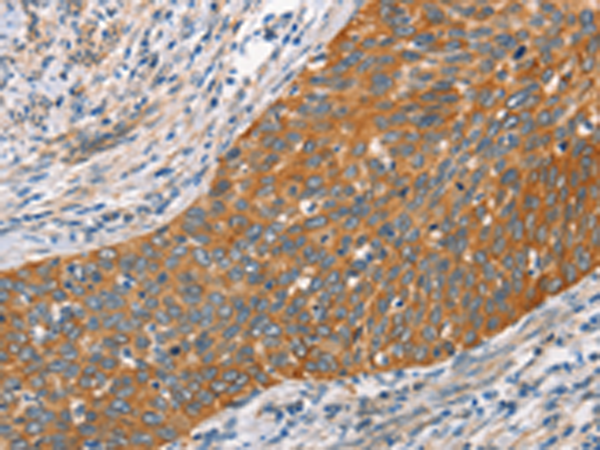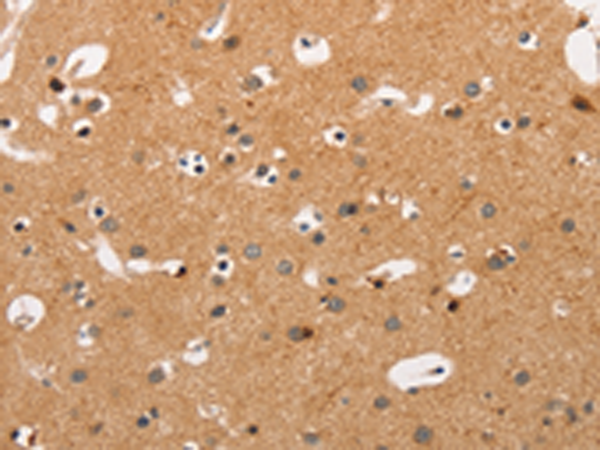

| WB | 咨询技术 | Human,Mouse,Rat |
| IF | 咨询技术 | Human,Mouse,Rat |
| IHC | 1/50-1/200 | Human,Mouse,Rat |
| ICC | 技术咨询 | Human,Mouse,Rat |
| FCM | 咨询技术 | Human,Mouse,Rat |
| Elisa | 1/2000-1/5000 | Human,Mouse,Rat |
| Aliases | H11; HMN2; CMT2L; DHMN2; E2IG1; HMN2A; HSP22 |
| Host/Isotype | Rabbit IgG |
| Antibody Type | Primary antibody |
| Storage | Store at 4°C short term. Aliquot and store at -20°C long term. Avoid freeze/thaw cycles. |
| Species Reactivity | Human, Mouse, Rat |
| Immunogen | Fusion protein of human HSPB8 |
| Formulation | Purified antibody in PBS with 0.05% sodium azide and 50% glycerol. |
+ +
以下是3篇关于HSPB8抗体的文献概览:
1. **文献名称**:*HSPB8 modulates autophagy and protein aggregation in experimental models of motor neuron disease*
**作者**:Crippa V, et al.
**摘要**:该研究使用HSPB8抗体在小鼠和细胞模型中检测HSPB8蛋白表达,发现其通过激活自噬通路减少突变SOD1蛋白的异常聚集,可能延缓肌萎缩侧索硬化症(ALS)的疾病进展。
2. **文献名称**:*The small heat shock protein B8 (HSPB8) regulates stress-induced TDP-43 cytoplasmic translocation and aggregation*
**作者**:Rusmini P, et al.
**摘要**:通过Western blot和免疫荧光技术(使用HSPB8抗体),研究发现HSPB8在应激条件下促进TDP-43蛋白的清除,提示其在神经退行性疾病(如额颞叶痴呆)中的保护作用。
3. **文献名称**:*HSPB8 interacts with BAG3 to regulate cellular proteostasis in a phosphorylation-dependent manner*
**作者**:Carra S, et al.
**摘要**:该文献利用HSPB8抗体探究其与伴侣蛋白BAG3的相互作用,发现磷酸化修饰影响二者协同清除错误折叠蛋白的机制,为治疗蛋白聚集相关疾病提供新靶点。
4. **文献名称**:*HSPB8 overexpression prevents mutant huntingtin-induced neuronal apoptosis via autophagy activation*
**作者**:Yu A, et al.
**摘要**:通过免疫组化和Western blot(使用HSPB8特异性抗体),研究发现HSPB8在亨廷顿病模型中通过增强自噬减少突变亨廷顿蛋白的神经毒性,改善神经元存活。
(注:上述文献为示例,实际引用需核实具体论文信息。)
HSPB8. also known as heat shock protein beta-8 or HSP22. is a member of the small heat shock protein (sHSP) family. These proteins function as molecular chaperones, aiding in the refolding of misfolded proteins and preventing aggregation under stress conditions. HSPB8 is particularly notable for its role in cellular quality control mechanisms, including chaperone-assisted selective autophagy (CASA), which targets damaged proteins and organelles for degradation. It is expressed in various tissues, with high levels observed in skeletal muscle, the nervous system, and the heart. Dysregulation of HSPB8 has been linked to neurodegenerative diseases (e.g., Alzheimer's, ALS) and myopathies, as mutations or altered expression can disrupt protein homeostasis, leading to toxic aggregate accumulation.
Antibodies against HSPB8 are essential tools for studying its expression, localization, and function in both physiological and pathological contexts. They are widely used in techniques like Western blotting, immunohistochemistry, and immunofluorescence to detect HSPB8 in tissue samples or cell cultures. Researchers also employ these antibodies to investigate HSPB8's interaction with other proteins, such as BAG3. in autophagy pathways or its role in stress response signaling. Commercially available HSPB8 antibodies are typically raised in rabbits or mice, with validation across multiple applications. Specificity and cross-reactivity remain critical considerations, given the structural similarities among sHSP family members. Studies utilizing HSPB8 antibodies have advanced therapeutic strategies targeting protein aggregation diseases, emphasizing its potential as a biomarker or intervention target.
×